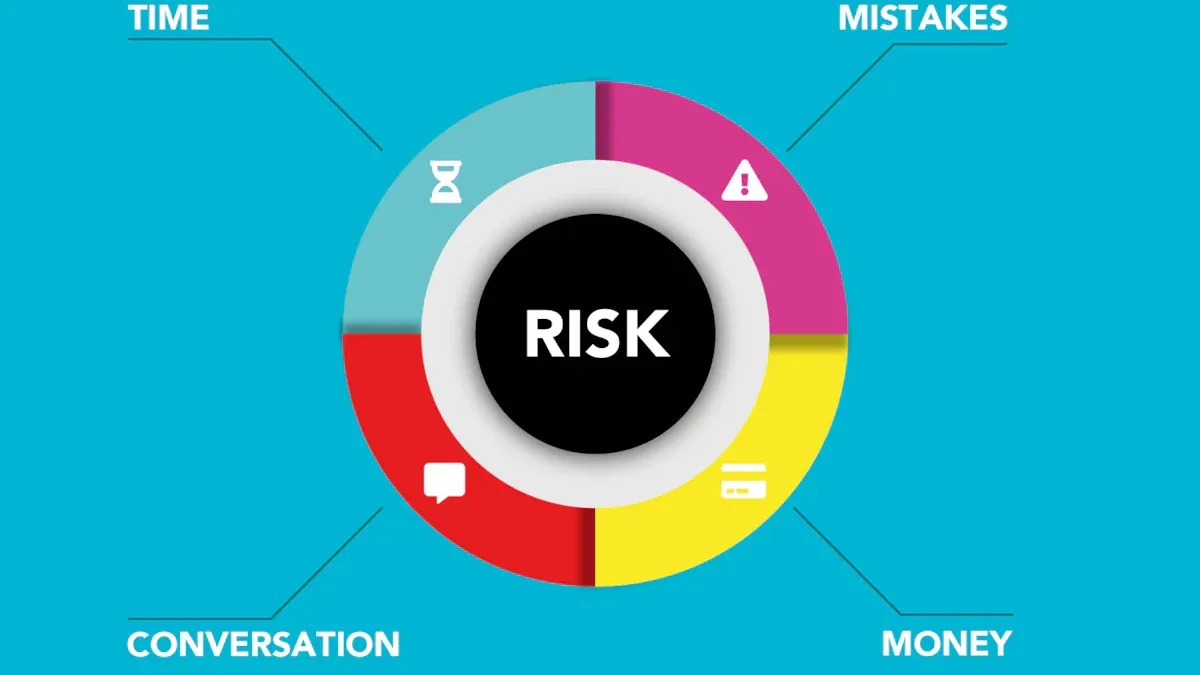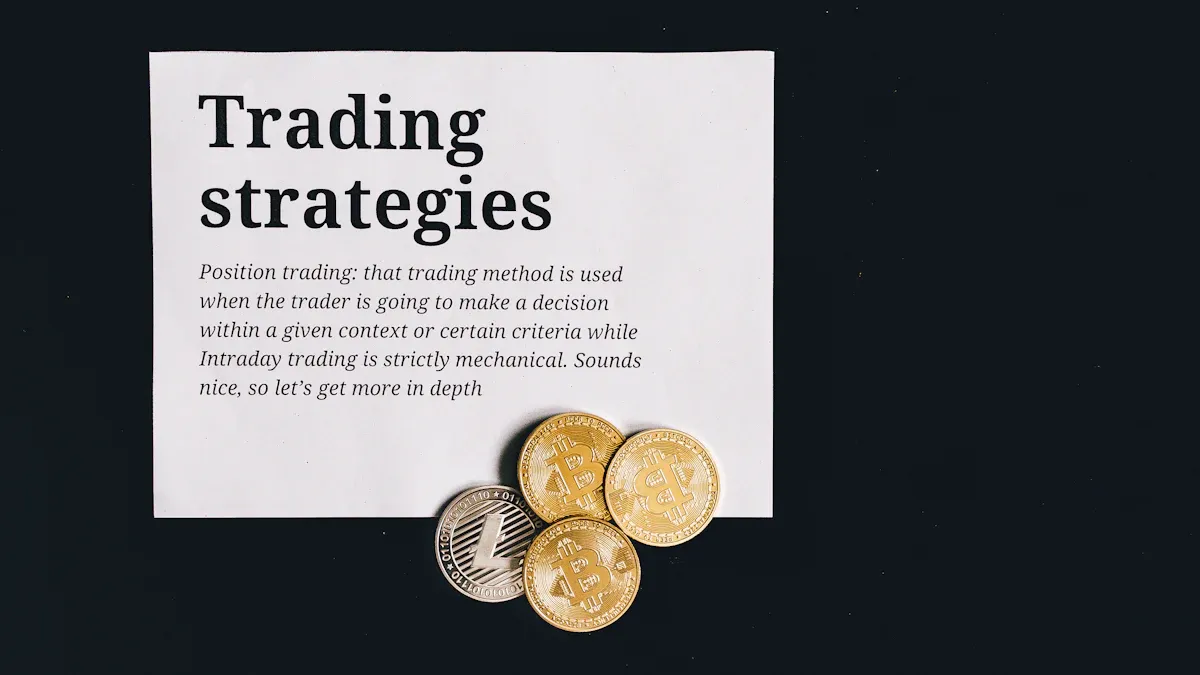- EasyCard
- Trade
- Help
- Announcement
- Academy
- SWIFT Code
- Iban Number
- Referral
- Customer Service
- Blog
- Creator
Say goodbye to "sell and go up"! Trailing stop-loss limit orders teach you smarter stop-loss and take-profit

Image Source: pexels
Do you often encounter the embarrassment of ‘sell and it rises’? Many investors make irrational decisions due to emotional influences. Fear and greed cause you to hastily sell during market downturns or blindly chase highs during uptrends. Investors are also prone to loss aversion, selling profitable stocks too early or holding losing assets too long. Trailing stop limit orders can help you dynamically protect profits and control risks. By mastering scientific setup methods, you can effectively improve your investment success rate.
Key Points
- Trailing stop limit orders can dynamically protect profits, reducing the risk of selling too early due to market fluctuations.
- Emotional trading leads to irrational decisions; using scientific profit-taking and loss-cutting tools can enhance investment performance.
- Reasonably setting trailing stop parameters requires flexible adjustments based on market volatility to avoid frequent triggering.
- Regularly monitoring and optimizing stop-loss strategies can help you better manage risks and improve portfolio stability.
- Trailing stop limit orders are suitable for highly volatile markets, effectively locking in profits and limiting losses.
Common Issues with Profit-Taking and Loss-Cutting

Image Source: pexels
The Frustration of ‘Sell and It Rises’
Many investors, when setting profit-taking and loss-cutting points, often encounter the phenomenon of ‘selling and then the price rises.’ This situation makes you feel frustrated and can easily affect subsequent decisions. You may experience this frustration due to the following reasons:
- You tend to sell profitable investments too early, missing out on further gains.
- Loss aversion makes you fear profit retracement, leading to premature profit-taking.
- You often set stop-losses based on subjective judgment or arbitrary values, without considering market volatility.
- Stop-loss points set too close are triggered by normal fluctuations, leading to early exits.
- Stop-loss points set too far increase losses during unfavorable market conditions.
- You fail to dynamically adjust stop-losses based on market changes, missing out on more profit opportunities.
You can learn to use trailing stop limit orders to dynamically protect profits and reduce the ‘sell and it rises’ phenomenon.
Risks of Emotional Trading
Emotional trading is a common pitfall in investing. You are easily influenced by greed and fear during market fluctuations, leading to irrational decisions. Common psychological factors include:
- The herd effect causes you to blindly follow the crowd during market uptrends, ignoring risks.
- Overconfidence leads you to overestimate your judgment, increasing risky behavior.
- Recency bias makes you focus only on recent market performance, ignoring cyclical fluctuations.
- Loss aversion causes you to sell too early in bull markets, fearing profit retracement.
- Anchoring bias and confirmation bias make you believe only the information you want to see.
If you trade emotionally, you may buy at market highs and sell at lows, missing rebound opportunities or incurring significant losses. Research shows that the impact of emotional trading depends on market conditions; it may occasionally improve performance but more often reduces long-term returns. You need to combine market trends with scientific profit-taking and loss-cutting tools to enhance investment performance.
Principles of Trailing Stop Limit Orders

Image Source: pexels
Working Mechanism
When investing, you often want to lock in profits while avoiding selling too early due to market fluctuations. Trailing stop limit orders can help you achieve this goal. Their core mechanism includes the following two points:
- Stop Price: When the market price falls to your set stop price, the system automatically activates the order.
- Limit Price: After the order is activated, it can only be executed at your set limit price or better, avoiding execution at extremely low prices due to sharp market fluctuations.
For example, you hold XYZ company stock, currently priced at $52. You worry about price drops but don’t want to sell due to temporary fluctuations. You can set a trailing stop limit order with a stop price of $50 and a limit price of $49. When XYZ falls to $50, the system activates your order and sells at $49 or higher. This approach allows you to protect profits while avoiding selling at low prices due to panic.
Differences from Standard Stop-Loss Orders
You may wonder how trailing stop limit orders differ from standard stop-loss orders? The table below helps you understand quickly:
| Order Type | Execution Method | Risk Management |
|---|---|---|
| Trailing Stop Limit | Offers price control, may not execute | Suitable for less volatile markets |
| Trailing Stop Loss | Converts to a market order, ensures execution | Suitable for fast-changing markets, may result in suboptimal prices |
When you use trailing stop limit orders, you can better control execution prices, especially suitable for less volatile ETFs or stocks. Standard stop-loss orders are better for scenarios requiring quick execution but may result in prices far below expectations. You can choose the appropriate tool based on market conditions and your needs to enhance risk management capabilities.
Setting Up Trailing Stop Limit Orders
Steps and Methods
If you want to set up trailing stop limit orders scientifically, you can follow these steps:
- Choose algorithmic trading software or a brokerage platform that supports trailing stop limit orders.
- Enter the ETF or stock code you want to sell and select the sell operation.
- Choose the order type as a trailing stop limit order.
- Set the trailing parameters. You can choose to set the trailing distance in points or percentages. For example, if the current ETF price is $100, you can set the trailing distance as $5 or 5%.
- Set the limit price. The limit price is the lowest acceptable execution price, preventing execution at extremely low prices due to sharp market fluctuations.
- Choose the order validity period. You can select ‘valid for the day’ or ‘good till canceled.’
- Review the order details and submit after confirming accuracy.
Tip: You can first use a demo account to backtest and verify if your trailing stop strategy is reasonable. In actual operations, it’s recommended to regularly monitor orders and adjust parameters flexibly based on market changes.
ETF Volatility and Parameter Adjustment
The volatility of an ETF directly affects the effectiveness of trailing stop limit order settings. You need to flexibly adjust stop-loss points based on the ETF’s actual volatility:
- If the ETF has high volatility, setting a stop-loss too tight may be triggered by daily price fluctuations, leading to frequent selling and missing subsequent gains.
- If the ETF has low volatility, setting a stop-loss too wide may fail to stop losses in time, increasing loss risks.
- You can observe the ETF’s historical volatility range to reasonably set the trailing distance. For example, if recent daily fluctuations are around $2, you can set the trailing distance to $2.5-$3 to avoid frequent triggering while effectively protecting profits.
When dynamically adjusting stop-loss points, you should also note:
- As the ETF price rises, adjust the stop-loss point upward promptly to lock in more profits.
- In cases of dividends or splits, adjust stop-loss parameters synchronously to avoid stop-loss failure due to price adjustments.
- Don’t rely solely on manual monitoring; use automated tools to reduce the risk of missing key price movements.
Common operational mistakes include:
- Setting stop-losses too tight, leading to frequent triggering.
- Ignoring ETF volatility, resulting in stop-loss points that don’t match actual fluctuations.
- Failing to adjust stop-losses as prices rise, missing opportunities to lock in profits.
- Ignoring factors like dividends or splits, causing stop-loss points to become invalid.
You can gradually improve the effectiveness of trailing stop limit orders through regular reviews and parameter optimization. Scientific setup and dynamic adjustments help you better protect profits and reduce risks.
Comparative Analysis
Flexibility
When investing, you often need to adjust strategies flexibly based on market changes. Trailing stop limit orders provide you with greater operational freedom. You can set appropriate trailing distances and limit prices based on the volatility of different ETFs or stocks. This way, no matter how market conditions change, you can adjust stop-loss points promptly to protect existing profits.
Standard stop-loss orders typically only allow setting a fixed price and cannot automatically follow market rises. If you use trailing stop limit orders, the system automatically raises the stop-loss point as prices rise, helping you lock in more profits. You don’t need to constantly monitor the market, making your trading strategy smarter and more efficient.
Profitability and Risk Control
While pursuing profits, you must also prioritize risk management. Many quantitative studies show that properly setting trailing stop limit orders can improve overall portfolio performance:
- Kaminski and Lo’s 2008 study showed that a 10% stop-loss strategy achieved higher returns and lower losses over 54 years.
- Snorrason and Yusupov’s 2009 study found that 15% to 20% trailing stop levels outperformed buy-and-hold strategies during volatile periods, especially in fluctuating markets.
- By setting a 10% trailing stop order, you can lock in profits as stock prices rise. When prices fall by more than 10%, the system automatically sells, helping you limit losses.
- This strategy allows you to manage risks effectively without constant market monitoring, indirectly enhancing overall portfolio profitability.
By adopting trailing stop limit orders, you can continuously lock in profits during market uptrends and stop losses promptly during downturns, balancing profitability and risk control.
Practical Tips
Parameter Optimization
To make trailing stop limit orders more effective, you must learn to adjust parameters flexibly based on market volatility. Market volatility directly affects the setting of stop-loss distances. In high-volatility markets, overly tight stop-losses are easily triggered by normal fluctuations, leading to premature exits. In low-volatility markets, stop-loss distances that are too wide may cause you to bear unnecessary risks. You can use indicators like the Average True Range (ATR) to measure market volatility. For example, many professional traders multiply the ATR by 1.5 or 3.5 as a reference for dynamic stop-losses. This makes stop-loss points more aligned with actual market conditions, reducing the likelihood of being triggered by ‘false breakouts.’
You can also optimize parameters through backtesting. Backtesting involves testing your strategy’s performance with historical market data. You can evaluate profits, maximum drawdowns, and win rates under different stop-loss distances to find the most suitable parameters for the current asset class. Regularly recording and analyzing trading logs can also help you identify which parameter combinations are more effective.
It’s recommended to reassess market volatility periodically and adjust trailing parameters promptly to maintain strategy adaptability.
Avoiding Pitfalls
When using trailing stop limit orders, you may encounter some common pitfalls:
- If you set stop-losses too tight in high-volatility markets, they may be frequently triggered, causing you to miss subsequent gains.
- If you use trailing stops on assets with low liquidity, large bid-ask spreads may cause stop-losses to be unnecessarily triggered.
- You cannot use the same stop-loss distance for all assets. Different assets have varying volatility and price levels, and fixed parameters reduce strategy effectiveness.
- If you ignore changes in market conditions and fail to adjust stop-loss parameters dynamically, the strategy may become ineffective.
You can use technical indicators (such as moving averages or support levels) to assist in determining stop-loss points, leaving reasonable room for price fluctuations. You should also avoid blindly tightening stop-losses during sharp market fluctuations and learn to adjust flexibly based on actual conditions.
Remember, scientific setup and dynamic parameter optimization are key to improving the effectiveness of stop-loss strategies.
By using trailing stop limit orders, you can effectively reduce downside risks, improving profit-taking and loss-cutting efficiency. Scientific setup and flexible application allow you to lock in profits and reduce emotional decisions during market volatility. The table below summarizes their advantages:
| Advantage | Description |
|---|---|
| Limit Losses | Automatically manages risks, preventing significant losses |
| Lock in Profits | Protects gains as prices rise, retaining profits during reversals |
| Eliminate Emotions | Sets exit points to avoid impulsive actions |
| Automatic Execution | No need for constant monitoring, adapts to different market environments |
You can combine your actual situation, continuously optimize strategies, and achieve stable portfolio growth.
FAQ
Which Investment Vehicles Are Suitable for Trailing Stop Limit Orders?
You can use trailing stop limit orders in highly volatile markets like U.S. stocks and ETFs to better protect profits and reduce risks.
How Do Trailing Stop Limit Orders Differ from Standard Stop-Loss Orders?
When you set a trailing stop limit order, the stop-loss point automatically adjusts upward as prices rise. Standard stop-loss orders remain fixed at a single price and do not change dynamically.
How to Choose an Appropriate Trailing Distance?
You can refer to the historical volatility range of the target asset. Generally, widen the trailing distance in high-volatility markets and tighten it in low-volatility markets to avoid frequent triggering.
Can Trailing Stop Limit Orders Fail to Execute Due to Price Gaps?
If the market price gaps past your set limit price, the order may not execute. You need to balance execution probability and price protection, setting the limit price reasonably.
Can Trailing Stop Limit Orders Be Used in U.S. Stock Accounts with Licensed Hong Kong Banks?
You can use trailing stop limit orders in some U.S. stock trading accounts with licensed Hong Kong banks. Check with your bank or brokerage platform for specific functionality.
If you’ve ever sold a stock only to watch it climb higher, you need the Trailing Stop Limit Order. This powerful tool helps you dynamically lock in profits while protecting against sudden reversals, effectively turning emotional trading into disciplined, automated strategy. However, the success of a dynamic strategy depends on its affordability, as frequent parameter adjustments and re-entry orders can be expensive if you face high transaction costs.
To ensure your advanced stop-loss strategy maximizes net returns, integrate the financial precision of BiyaPay. We offer zero commission for contract limit orders, a crucial advantage that drastically cuts the expense of executing the frequent adjustments and precise limit orders central to trailing stop strategies. Furthermore, our platform supports the swift, mutual conversion between fiat and digital assets like USDT, providing you with the fastest, most reliable pathway to fund your brokerage accounts for time-sensitive global investment. You can register quickly—in just 3 minutes without requiring an overseas bank account—and gain immediate access to US and Hong Kong Stocks. Leverage our real-time exchange rate checks to maintain transparent control over your funding costs. Open your BiyaPay account today and secure the operational efficiency your smart trading deserves.
*This article is provided for general information purposes and does not constitute legal, tax or other professional advice from BiyaPay or its subsidiaries and its affiliates, and it is not intended as a substitute for obtaining advice from a financial advisor or any other professional.
We make no representations, warranties or warranties, express or implied, as to the accuracy, completeness or timeliness of the contents of this publication.




Contact Us
Company and Team
BiyaPay Products
Customer Services
is a broker-dealer registered with the U.S. Securities and Exchange Commission (SEC) (No.: 802-127417), member of the Financial Industry Regulatory Authority (FINRA) (CRD: 325027), member of the Securities Investor Protection Corporation (SIPC), and regulated by FINRA and SEC.
registered with the US Financial Crimes Enforcement Network (FinCEN), as a Money Services Business (MSB), registration number: 31000218637349, and regulated by FinCEN.
registered as Financial Service Provider (FSP number: FSP1007221) in New Zealand, and is a member of the Financial Dispute Resolution Scheme, a New Zealand independent dispute resolution service provider.



















